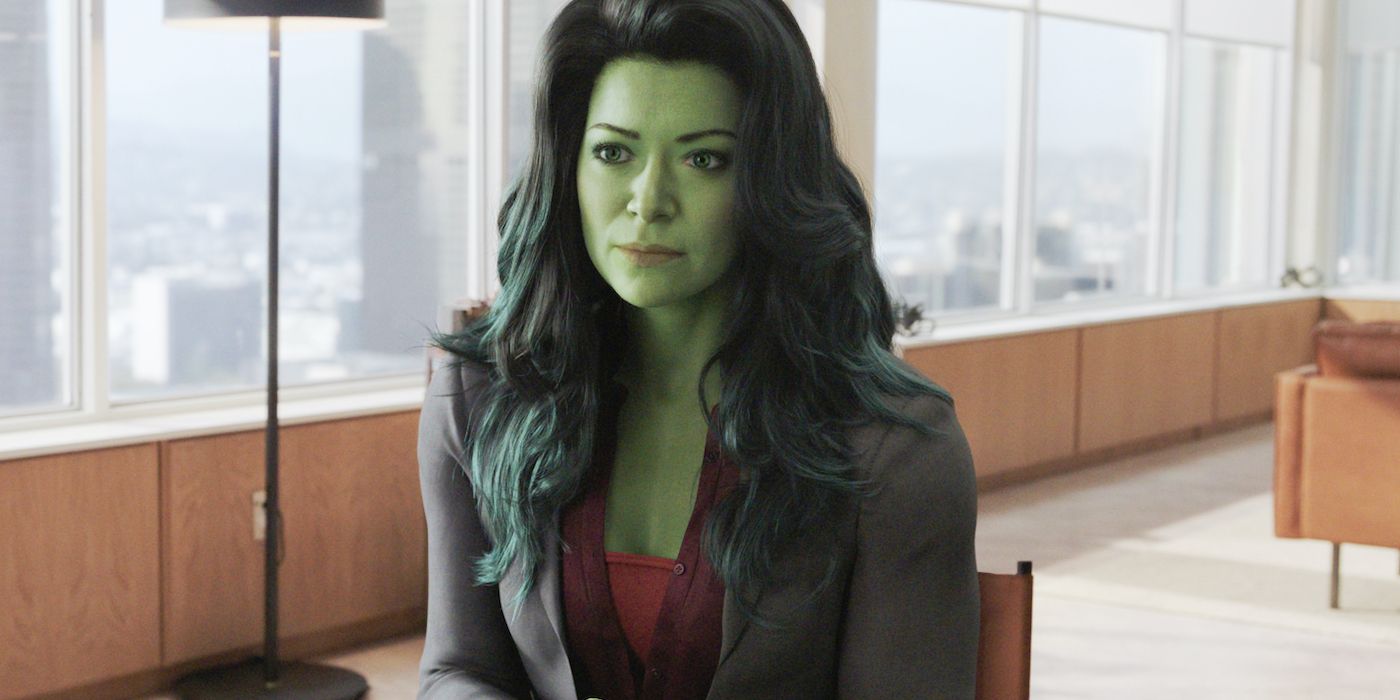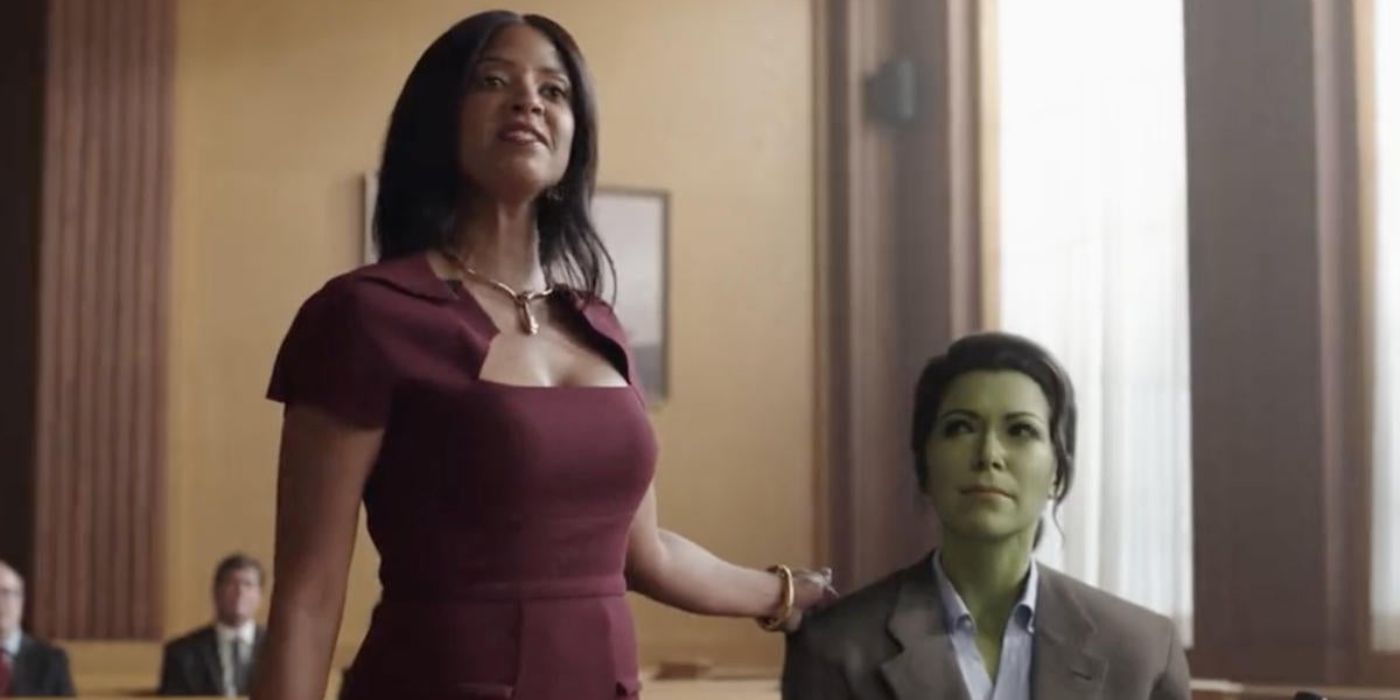Editor's Note: The following contains She-Hulk spoilers.
With the release of She-Hulk: Attorney at Law’s fifth episode, “Mean, Green, and Straight Poured into These Jeans,” the nine-episode series has officially crossed its halfway point. Each episode finds Jennifer Walters/She-Hulk (Tatiana Maslany) humorously navigating her personal life, the courtroom, and her newfound superpowers. Having crossed the halfway point, it is a pretty safe bet that the show will not suddenly veer away from its modest concerns and into an end-of-the-world multicolor beam battle that has the potential to change the universe as its characters know it. Rather than embracing the high stakes approach of the MCU, She-Hulk has veered into lower stakes with glee.
As a franchise, the films of the Marvel Cinematic Universe largely feature narratives with world-changing or reality-altering stakes. For the most part, the narratives of the Disney+ MCU series keep consistent with this approach. WandaVision features a reality-altering climax, Loki deals with the destruction of time and space, Moon Knight explores the consequences for the afterlife, and so on. Even Hawkeye, generally considered the smallest-scale series so far, deals with the ramifications of the Battle of New York, the worldview-shifting event from The Avengers. No such narrative concerns are found in She-Hulk.
She-Hulk Is Content Exploring the Drama of Everyday Life
Instead, She-Hulk is content exploring the relatively modest concerns that impact Jennifer’s daily life. In Episode 2, “Superhuman Law,” Jennifer tries not to stand out too much at her new job. Episode 4, “Is This Not Real Magic?” finds Jennifer traversing the modern dating scene. Episode five’s central conflict is a trademark lawsuit between Jennifer and her rival, Titania (Jameela Jamil). Refreshingly, each episode allows these minute conflicts stand on their own, rather than feeling like they are building blocks for a doomsday-level threat in the show’s final episode. Certainly, the many supporting characters and cameos will be an integral part in the season’s finale, but they do not feel like a handful of chess pieces being moved toward an intergalactic conclusion.
She-Hulk Subverts Audience Expectations from Episode 1
Cleverly, She-Hulk subverts audience expectations from the first episode. The series’ pilot, “A Normal Amount of Rage,” certainly suggests the show was heading toward yet another transuniversal conflict of epic proportions when a spaceship from Sakaar causes Jennifer and Bruce Banner (Mark Ruffalo) to get into a car crash. Since this crash is the catalyst for Jennifer obtaining her She-Hulk powers (Bruce’s blood enters her bloodstream during the crash), it would seem like the overarching narrative would involve a showdown between the two Hulks and a Sakaarian enemy. And yet, Bruce (as Smart Hulk) casually flies off into space aboard a Sakaarian ship in the second episode. When he leaves Earth, he seemingly takes the potential for an intergalactic climax with him, allowing the series to focus on the smaller scale issues of Jennifer’s daily life.
Even the series’ antagonists help to keep the series’ stakes low. So far, none of the villains pose Armageddon threats for She-Hulk. Titania, who one would think would be She-Hulk’s arch nemesis after her appearance in the show’s pilot, ends up being a mostly ineffectual legal rival. Emil Blonsky (Tim Roth) appears, but only as a trying defendant Jennifer must defend in a superhuman law case. The Wrecking Crew are depicted as a street gang who are easily defeated by She-Hulk when they attack her. Even the non-villainous antagonists pose only minor threats to the narrative. Donny Blaze (Rhys Coiro) accidentally opens a dimensional portal that unleashes a horde of demons, but She-Hulk, accompanied by Wong (Benedict Wong), makes quick work of them. Runa (Peg O’Keef), a shape-shifting elf, is more of an annoyance than an antagonist, and only exists to set up a hilarious Megan Thee Stallion cameo. Significantly, apart from Titania, these antagonists are really only present in the specific episode in which She-Hulk deals with them. The show keeps its stakes low by relying on episodic conflicts, rather than building toward multi-villain mayhem.
Despite its change-of-stakes approach, the show never feels disconnected from the MCU as it retains the franchise’s comedic charm, colorful aesthetic, and reverence for superheroism. Fully assuming its status as the MCU’s first workplace comedy, each episode of She-Hulk is packed with clever dialogue and tongue-in-cheek cultural comedy — look no further than new fan-favorite character Madisynn (Patty Guggenheim). From the cold blues of Blonksy’s prison cell to the saturated reds of Donny Blaze’s magic show, each scene reflects the vivid colors of the comics which inspired the show. Even with the show’s meta fourth wall-breaking, She-Hulk never loses its respect for the superheroes at its core. Skillfully marrying Marvel Studios’ sensibilities with lower than end-of-the-world stakes, She-Hulk proves there is room for any kind of stakes within the MCU.


